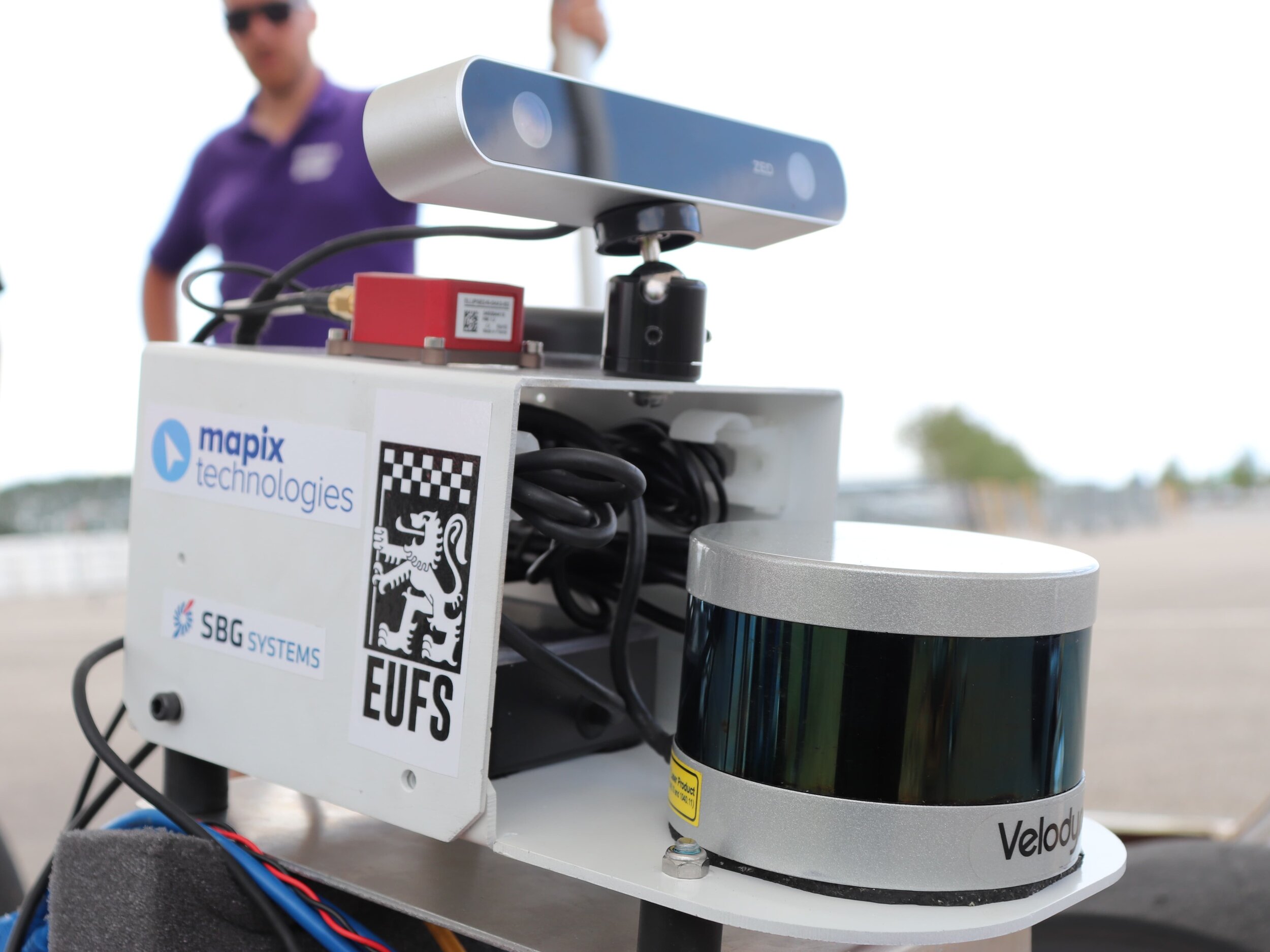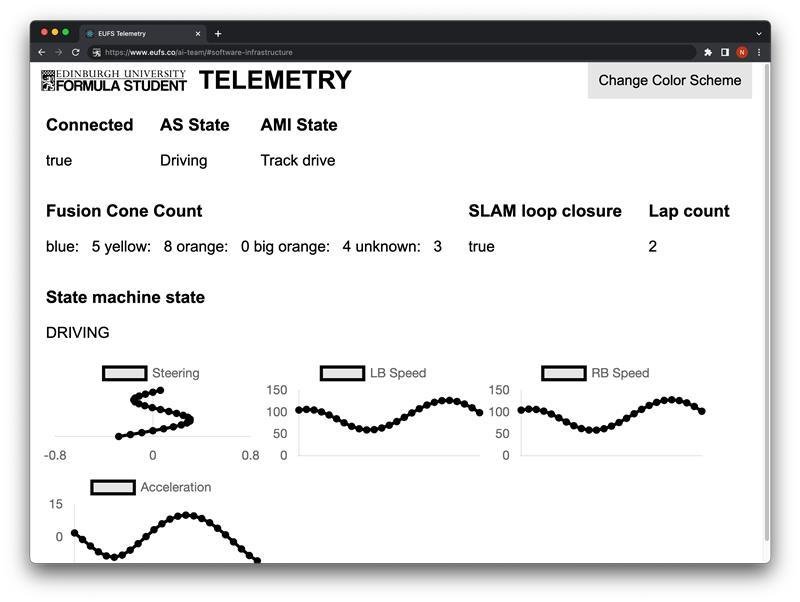The Future is Driverless…
Unlock your potential.
With the rise of driverless cars in recent years, our team responded in the only way we know how – with curiosity and enthusiasm. Since the foundation of our Driverless team, students have had the opportunity to explore this cutting edge technology in the context of the Formula Student competition.
Members can expect to be a part of the full engineering experience; from design and manufacturing to testing and racing our autonomous cars. Along this journey, skills are developed, lessons are learnt, and lifelong friends are made.
Become a part of history.
The Driverless team has a rich history of success - having won the Formula Student AI (FS-AI) classification every year since the inaugural competition in 2018. We were the overall most successful team at Formula Student UK 2023, boasting an impressive 6 trophies. In addition, we were the first UK team to complete all dynamic events with the provided autonomous vehicle.
If that wasn’t enough, we are working towards being the first UK society to build our own fully autonomous racing car. Over the coming years we are looking to finish and refine this concept, with the aim of racing internationally at other Formula Student competitions.
Meet our Technical Teams
Discover more about our technical teams below…
Electrical Department
-

Powertrain Team
Interdisciplinary team focusing on the electrical and mechanical aspects of designing the accumulator, inverter, motor, and differential.
-

PCB Design Team
Design advanced electronic systems and circuits which are required for the monitoring and control of the car.
-

Electrical Distribution Systems (EDS) Team
Responsible for designing, implementing, and maintaining the intricate network of electrical wiring and connections.
-

Control Systems Team
Focuses on the control mechanisms of autonomous and manual driving modes ensuring precise and real-time management of the vehicle's dynamics, cooling and safety.
Mechanical Department
-

Autonomous Hardware Team
Responsible for the mechanical integration of autonomous components with the vehicle. including actuators, and emergency brakes.
-

Vehicle Dynamics Team
Developing the suspension and wheel assemblies to give balanced handling and maximum grip. Composite materials and advanced simulation software is used for optimisation.
-

Chassis Team
Designing and manufacturing a stiff yet light main structural welded space-frame for the car, and also connecting the suspension, accumulator and motor pick-up points.
-

Aerodynamics and Ergonomics
Develops the car's aerodynamic package which will provide the driver more grip. Ensures all the controls the driver may interact with in the cockpit are reachable, safe, and ergonomic.
Software
-

Perception
Perceive the environment by extracting cone positions.
-

Localisation & Mapping
Understand the motion of the car and create a map of the track.
-

Planning & Control
Make the car go fast!
-

Software Infrastructure
Develop the processes, libraries, and tooling essential for other sub-teams.
-

Simulation
Replicate real-world scenarios in simulation.
-

Statics
Consider the real-world applications of our AI technology from a technical and business perspective.
Become part of the Team!
After Welcome Week we will release a link for a sign-up form. Stay tuned!
Watch us in action…
Mechanical and Electrical Teams
Autonomous Hardware Team
This team focuses on the mechanical asepects. In the past, this team has retrofitted the chassis from a legacy internal combustion car with an all-new electric system. This team is also responsible for designing and manufacturing the mechanical components of all autonomous systems. Very close collaboration with other sub-teams (especially powertrain and electronics) is needed, as hardware integration has to work out where components go on the car & physically make it happen. For the year 2022-2023, the primary focus of hardware integration is to finish & test all major mechanical subsystems, such as cooling, brakes, or steering.
Potential projects:
Emergency brake system – manufacture the design, then test & improve
Test & improve hardware part of autonomous steering
Firewall (seat) redesign & manufacture
General testing of all hardware
Skills to be learned:
CAD Design (SolidWorks)
Technical drawing generation (insight into GD&T)
FEA modelling (Ansys, SolidWorks)
Knowledge on manufacturing processes and techniques
Hands-on experience in the workshop (drilling, grinding, assembling, potential welding)
This sub-team is responsible for the car’s tractive power. Being an electric vehicle, a powertrain system must be designed and created such that it provides enough power to win races. The powertrain is an important component in electric vehicles, and will continue to be a development focus for many years. Join us if you are interested in keeping the automotive industry alive and exciting, long after the age of internal combustion.
Powertrain
Potential projects:
• High Voltage Battery Design, Control, and Testing
• Traction Motor and Encoder Integration, and Drivetrain Design
• DC-link, High Voltage Disconnector (HVD), and Power Electronics Design and Testing
• Battery, Motor, and Inverter Cooling System
• Low Voltage Battery Design
Skills to be learned:
Involved understanding behind electrical powertrain systems
CAD Design Software (Drawings and Renderings)
Altium Design Software (Circuit and PCB designs)
Coding Software for design (Python/MATLAB/C)
Power Lab High Voltage Circuit design, safety, construction, optimisation and testing
Electronics
Like any complex system, our car features many sensors and physical components which need to be controlled by software. The Driverless Electronics team is tasked with designing systems such as the automatic steering and braking, several safety indicators, sensors to gather data, and the onboard computer - tying them all together through CAN.
All systems are designed using industry standard software, built and programmed on campus, and then tested for functionality. If the integration of hardware with software sounds interesting, Driverless Electronics is the team for you!
Potential projects:
Vehicle Control Unit (VCU)
CAN communication
Steering and brake actuators
Accumulator temperature monitoring
Battery Management System (BMS)
Skills to be learned:
PCB design (Altium)
Programming microcontrollers
Circuit soldering for SMD and through-hole components
Circuit testing and debugging
Electrical wiring
Software Teams
Perception
The Perception team is responsible for designing and implementing detection algorithms to extract the position of traffic cones from the environment using LiDAR and stereo camera sensors. This covers a wide range of areas in the field of robot perception, including sensor fusion and modelling, stereo depth estimation, 2D object detection on images and 3D object detection on LiDAR point clouds. If any of those spark your interest, this might be the sub-team for you!
Potential projects:
Develop data collection and processing pipelines for machine learning (MLOps)
Develop object detection algorithms for stereo camera and LiDAR sensors
Develop multimodal sensor fusion methods
Localisation and Mapping
Localisation & Mapping is responsible for combining information from a wide range of different sensors to form an understanding of the position and motion of the car, and for creating a map of the track. This year will focus on integrating new sensors, developing a custom sensor fusion package, create tools for evaluation, and implementing Simultaneous Localisation and Mapping (SLAM) algorithms. If any of those spark your interest, this might be the sub-team for you!
Potential projects:
Interfacing with a new ground speed sensor
Implementation of wheel slip into odometry calculations
Develop our in-house sensor fusion algorithm (EKF)
Creating evaluation infrastructure for our algorithms
Planning and Control
Planning and control takes care of all the path planning and path optimization, as well as controlling the vehicle to stay on the path. This year, we have set a goal of matching the performance of a human driver. To get there, this sub-team will be working on better path optimization routines, new approaches to controlling the car and data analysis of the driving dynamics. If any of those spark your interest, this might be the sub-team for you!
Potential projects:
Developing an MPC controller
Improving existing Pure Pursuit controller
Controller performance evaluation
Planned path evaluation
Local path optimization
Global path planning
Software Infrastructure
Software Infrastructure is responsible for a large variety of tasks. Tasks which are more similar to traditional software engineering, rather than being specific to robotics. This year will focus on projects such as telemetry, a data portal, and Continuous Integration and Deployment pipelines. If any of those spark your interest, this might be the sub-team for you!
Potential projects:
Data collection, processing, and storage
Analysis tools for the data
Our CLI (command line interface) to improve DX (developer experience)
System for configuration
System for deploying our software
Simulation
The Simulation team is responsible for creating a 3D simulation environment that captures features of the real world useful for testing our autonomous systems. Features include, vehicle modelling, sensor simulation, environment generation, synthetic data generation and much more. If any of those spark your interest, this might be the sub-team for you!
Potential projects:
Procedural environment generation
Virtual CAN Simulation
Data analysis to correlate simulation
Improve software architecture
Improving and adding automated tests to CI
Statics
Statics
Statics is a creative, presentation-based team. We explore elements of business and the realistic application of driverless and traditional tech. Throughout the year, we will explore existing business models, devise our own business plan, and practice giving pitches. The year will culminate in a Business Plan Presentation at Formula Student UK in Silverstone.
In this team, you will gain an insight of the state of the driverless vehicles industry right now, an area which is bubbling with opportunity for the future. You will also develop research skills which will benefit you academically and beyond. No experience in AI or business is necessary; a keen interest is all we ask.
Potential projects:
Business Plan Presentation
Research (encompassing business, AI, engineering)
Design (slides and accompanying documents)
Presentation
Real World AI
Research (in-depth AI topics)
Design (slides and accompanying documents)
Presentation


















